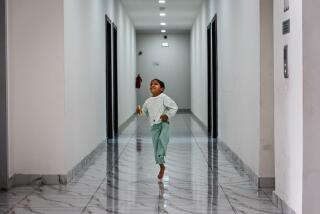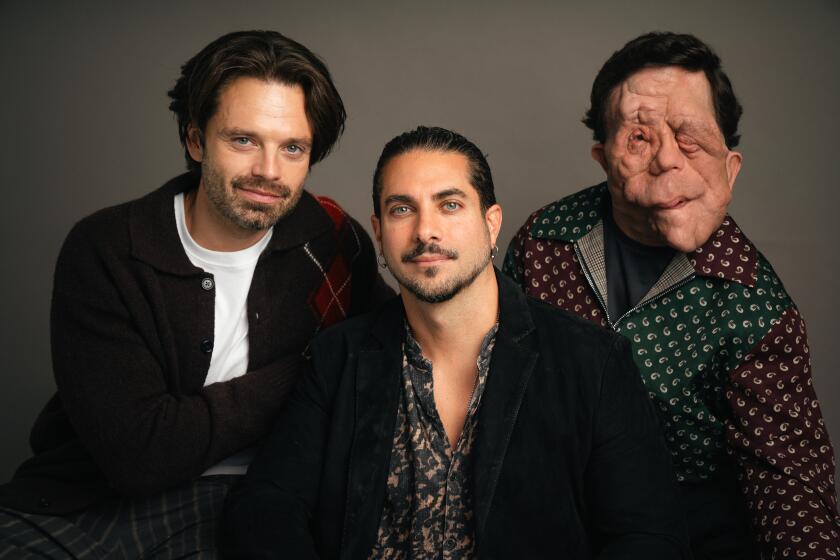Review: A remarkable story, the documentary âChildren of the Enemyâ tests the will

The Times is committed to reviewing theatrical film releases during the COVID-19 pandemic. Because moviegoing carries risks during this time, we remind readers to follow health and safety guidelines as outlined by the Centers for Disease Control and Prevention and local health officials.
To quote the late, great Tom Petty: âThe waiting is the hardest part.â Just ask Patricio Galvez, the empathetic protagonist of writer-director Gorki Glaser-MĂźllerâs timely and unnerving documentary âChildren of the Enemy,â which tracks Galvezâs heroic, near-two-month journey in 2019 to rescue his orphaned grandchildren from a Syrian refugee camp.
How this Chilean-Swedish musician came to have seven grandkids, ages 1 to 8, being held in the notorious al-Hol detention camp is a singular story indeed. It began when his daughter, Amanda, converted to Islam at 18. She then married fellow Swede and Muslim convert Michael SkrĂĽmo, who would become Scandinaviaâs most infamous ISIS terrorist. Radicalization led the couple to relocate with their four small children to Raqqa, Syria, in 2014 to join the fight for a caliphate. They would go on to expand their young family by three.
In January 2019, Amanda, pregnant with her eighth child, was killed in an airstrike; Michael reportedly was shot to death two months later during the fall of the caliphate. Thatâs when their children were sent to the teeming and squalid al-Hol facility. Meanwhile, indecision and an apparent lack of sociopolitical will by Swedish authorities kept these âchildren of the enemyâ stuck in the dangerous camp and dangling in limbo.
After learning from a London human rights lawyer that, despite some health issues, his grandkids were remarkably still alive, Galvez, with filmmaker friend Glaser-MĂźller (also Chilean-Swedish) in tow to document events, decided to fly from Sweden to the Middle East and work with the various humanitarian and diplomatic factions to secure the childrenâs release.
But holed up in a hotel in Erbil, Iraq, less than 200 miles from the Syrian border, thereâs just so much Galvez can do to drive the confusing and complex process. He largely relies on anxious phone calls and bits of uncertain information from the powers that be as to when â and if â heâll ever see his grandkids, much less return with them to Sweden.
So we wait â and wait â with Galvez, whoâs rarely out of Glaser-MĂźllerâs viewfinder, as the days frustratingly tick by, broken up by press interviews, web browsing and fleeting signs of hope. The result is a gritty, vĂŠritĂŠ look at a grandfatherâs anguish and resolve, a kind of video diary that mostly eschews the usual documentary bells and whistles.
Unfortunately, the tedium of Galvezâs on-hold state sometimes bleeds into the viewing experience. Glaser-MĂźller could have used the downtime to provide more insight into such personal things as Galvezâs musical career and relationships (he divorced Amandaâs mother nearly 30 years earlier, when their daughter was a toddler; he also has two teenage children, briefly seen here, but is no longer with their mom), as well as how he managed the finances of this costly international travel ordeal.
So despite Galvezâs many moving displays of emotion and mentions that he could have been more proactive and vigilant about Amanda, weâre often left to fill in the gaps about this seemingly resilient bohemian with the unruly black hair, guitar-pick fingernails and ease at toggling between Swedish and his native Spanish (with some English tossed in too).
The film really gains steam when, after an aborted trip to the Syrian border, Galvez unites with his grandchildren, meeting the youngest three for the first time, as theyâre suddenly transported to the Swedish consulate in Erbil. He takes them back to his hotel suite â which he has lovingly stocked for their arrival â to wait again until arrangements are finalized to return with the brood to Sweden.
Itâs a chaotic interval as Galvez, with help from Glaser-MĂźller and an array of volunteers, tends to these clearly disoriented, overwhelmed and needy kids. That the childrenâs eyes are eerily blurred out here (for identity protection) limits our emotional and visceral connection with the towheaded septet. Still, we canât help but feel Galvezâs primal love for them.
Meantime, when Amandaâs contentious mother, who had converted to Islam along with her daughter, intrusively arrives in Erbil to be with her grandchildren, she and Galvez experience a culture clash that turns proprietary and he sends her packing. Itâs a reality-TV-worthy moment; thereâs obviously a thorny â and unexplored â rabbit hole of history between them.
The dire theme of innocent children being blamed for âthe sins of the fatherâ â and the attendant social and political turbulence they face â as efforts are made to find these youngsters a safe and loving place in the world receives a vital spotlight here. (An estimated 40,000 children are still trapped in northeast Syriaâs al-Hol and Roj refugee camps.)
'Children of the Enemy'
In Swedish, Spanish and English with English subtitles
Not rated
Running time: 1 hour, 36 minutes
Playing: Starts Nov. 17, Laemmle Newhall
More to Read
Only good movies
Get the Indie Focus newsletter, Mark Olsen's weekly guide to the world of cinema.
You may occasionally receive promotional content from the Los Angeles Times.










